Potřebujeme váš souhlas k využití jednotlivých dat, aby se vám mimo jiné mohly ukazovat informace týkající se vašich zájmů. Souhlas udělíte kliknutím na tlačítko „OK“.
ASTM D5907-13
Standard Test Methods for Filterable Matter (Total Dissolved Solids) and Nonfilterable Matter (Total Suspended Solids) in Water
Automaticky přeložený název:
Standardní zkušební metody pro filtrovatelný látek (celkem rozpuštěných pevných látek) a Nonfilterable látek (celkových nerozpuštěných látek) ve vodě
NORMA vydána dne 1.6.2013
Informace o normě:
Označení normy: ASTM D5907-13
Poznámka: NEPLATNÁ
Datum vydání normy: 1.6.2013
Kód zboží: NS-33044
Počet stran: 9
Přibližná hmotnost: 27 g (0.06 liber)
Země: Americká technická norma
Kategorie: Technické normy ASTM
Kategorie - podobné normy:
Anotace textu normy ASTM D5907-13 :
Keywords:
dissolved matter, filterable matter, nonfilterable matter, suspended matter, total dissolved solids, total suspended solids, ICS Number Code 13.060.60 (Examination of water for physical properties)
Doplňující informace
| Significance and Use | ||||||||||||||||||||||||||||||||||
|
4.1 Solids, both as filterable matter (TDS) and nonfilterable matter (TSS), are important in the treating of raw water and wastewater, and in monitoring of streams. 4.2 Waste solids impose a suspended and settleable residue in receiving waters. Suspended and soluble materials provide a matrix for some biological slime and, in sufficient quantity, impair respiration of organisms. These solids may create nuisance slime beds and odors while imposing a long-term biological oxidation load over limited receiving water areas. 4.3 Knowledge of suspended and soluble materials is important in treating raw water supplies. Knowledge of solids loading can aid in determining the type or amount of treatment, or both, necessary to make the water acceptable for use. Such information may also be used to determine acceptability of water after treatment. Too little treatment may not be desirable and excess treatment costs money. 4.4 Stream monitoring is important for environmental reasons, such as compliance with discharge permits. Stream improvements, water pollution monitoring, mass wasting, algal studies, and sediment loads are but a few of the many reasons streams are monitored. |
||||||||||||||||||||||||||||||||||
| 1. Scope | ||||||||||||||||||||||||||||||||||
|
1.1 These test methods cover the determination of filterable matter, total dissolved solids (TDS), and nonfilterable matter, total suspended solids (TSS), in drinking, surface, and saline waters, domestic and industrial wastes. The practical range of the determination of nonfilterable particulate matter (TSS) is 4 to 20 000 mg/L. The practical range of the determination of filterable matter (TDS) is 10 mg/L to 150 000 µg/g. 1.2 Since the results measured by this test are operationally defined, careful attention must be paid to following the procedure as specified. 1.3 This method for the determination of nonfilterable matter (TSS) must not be used when water samples were collected from open channel flow. For the determination of matter collected in open channel flow use Test Methods D3977. 1.4 The test methods appear in the following order:
1.5 The values stated in SI units are to be regarded as standard. No other units of measurement are included in this standard. 1.6 This standard does not
purport to address all of the safety concerns, if any, associated
with its use. It is the responsibility of the user of this standard
to establish appropriate safety and health practices and determine
the applicability of regulatory limitations prior to use.
Standard Practice for Determination of
Precision and Bias of Applicable Test Methods of Committee D19 on
Water Standard Practices for Sampling Water
from Flowing Process Streams Standard Guide for Management Systems in
Laboratories Engaged in Analysis of Water Standard Test Methods for Determining
Sediment Concentration in Water Samples Standard Guide for Reporting Results of
Analysis of Water Standard Terminology Relating to Water
(Includes all amendments and changes 2/14/2024). Standard Guide for Equipment for Sampling
Water and Steam in Closed Conduits (Withdrawn 2003) Standard Guide for Sampling Fluvial
Sediment in Motion Standard Practice for Writing Quality
Control Specifications for Standard Test Methods for Water
Analysis Standard Practice for the Preparation of
Substitute Wastewater Standard Practice for Conducting an
Interlaboratory Study to Evaluate the Performance of an Analytical
Method Standard Practice for the Evaluation of
Single-Pan Mechanical Balances Standard Practice for Calibration of
Non-Automatic Weighing Instruments Standard Specification for Reagent
Water Standard Test Methods for Specific
Gravity of Water and Brine (Withdrawn 2022) |
Podobné normy:
Historická
1.1.2014
Historická
15.7.2009
Historická
1.2.2009
Historická
1.2.2014
Historická
15.6.2013
Historická
1.2.2009


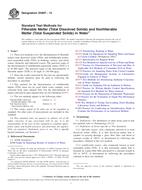
 ASTM D4822-88(2014)..
ASTM D4822-88(2014)..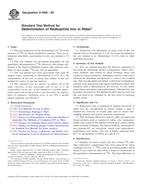 ASTM D4922-09
ASTM D4922-09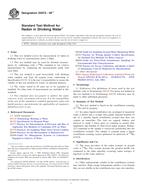 ASTM D5072-09e1
ASTM D5072-09e1 ASTM D5391-14
ASTM D5391-14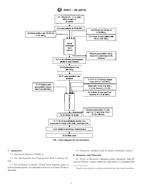 ASTM D5811-08(2013)..
ASTM D5811-08(2013)..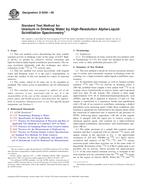 ASTM D6239-09
ASTM D6239-09
 Cookies
Cookies
